
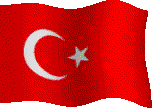


WELCOME TO IZMIR GUIDE..
![]()
WE WOULD LIKE TO WELCOME YOU IN HEAVEN OF HISTORY, SUN, SEA AND NATURE
*
*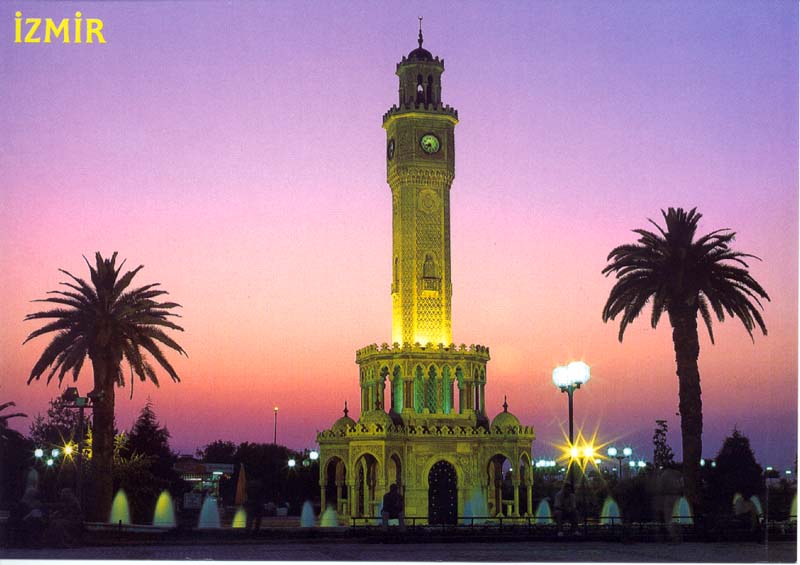
How many cities on
earth are there that have a 5,000-year-long history?That
have had people walking on their streets and in their squares for five
millennia?
I
am İzmir. Hello and welcome
Beautiful İzmir
!
İzmir is the
third largest city in Turkey, with a total land area of 12,762 square kilometres
and a population of more than three million people.This city, one of Turkeys
most important socioeconomic and cultural centres, also has within its borders
the biggest gulf to be found along the countrys Aegean coast.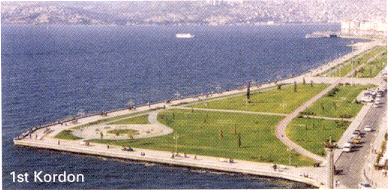
Whats the weather like?
When you arrive in İzmir, you will
be greeted by a very clean atmosphere, something that you will more fully
appreciate after you have breathed in the fresh air.İzmir is located in one of
the worldslargest oxygen zones.If you visit İzmir during the summer, which
runs from March until October, hot and sunny days await you; however, if you
visit between November and March, dont be surpised to find cool, rainy days
that provide mild and beautiful winterweather.İzmirs climate is such that
even during the winter there is no drasticchange in temperature.The Aegean coast
enjoys a unique, cool wind during the summer months that tempers the high
temperatures, acting as a natural air-conditioner that keeps you feeling cool
and fresh all day long.
Homers city
İzmir was formerly called Symrna
after the Amazon warrşor-queen of hellenic mythology.Throughout history İzmir
has been home to many civilisations, celebrating its symbolic 5,000th birthday
in the year 2000.With its unique historical background, the city stil bears
traces of the lonian, Lydian, Phrygian, Alexandrian and Pergamon kingdoms, as
well as the Roman, Arab, Seljuk and Otoman empires.
City
of fairs and festivals Izmir
International Fair
Another attribute
of İzmir, one of Turkeys most important toursim and business centres, is its
reputation as the city of fairs. It is referred to by this name because of
the İzmir Internetional fair, which has been held here for the past 71
years.The Kültürpark (Culture Park) Fairground, with its 421.000
m2 of greenery, is situated in the city centre and is the venue for many
of the fairs staged in İzmir.Plans are currently under way to hold other
business and commercial activities in this area.This year İzmir will be hosting
its 73rd İzmir International Fair.
İzmir
International Festival
İzmir has playd host to İzmir International
Festival for 18 years.This festival showcases İzmirs strength
in international culture and art
events.Every year thousands of art lovers from
all over the world participate in this festival, which is spread throughout the
city and held in many different venues.In addition to the Culture Park
festivities, events are also put on at the Agora, the Atatürk and Sabancı
cultural centres, all of which are located in the city centre.
A brief at the history of İzmir
According to archaeological finds and historical
sources İzmir as a city mentioned in 3000 B.C. During ancient times İzmir was
known as Symrna and was initially built on the Tepekule site known today as
Bayraklı in the year 3000 B.C.
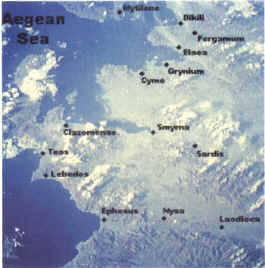
The
Carian, Lycian and Lydian civilisations enjoyed their golden days in İzmir
between the 7th and 6th centuries B.C. The Lydians, who began to establish a
kingdom towards the beginning of the seventh century B.C., made Sardes, situated
in the centre of the Aegean region, their capital.They were the first
civilisation in history to mint coins out of gold and silver.During this period
(towards the end of the seventh century B.C. and the beginning of the sixth
century B.C.) the Lydian king Alyattes invaded and destroyed İzmir, which was
later invaded by the Persians (546-334 B.C.). In spite of this second invasion
the influence of the Lydian civilisation continued until arround 300 B.C. During
the reign of the Persians in western Anatolia, the Grek and Persians cultures
interacted, and as a result monuments were created in the Greco-Persians style.
*
*
HISTORY
The city was under control of the Pergamon Kingdom for some time after
the death of Alexander the Great.The city once again began to thrive in 190 B.C.
while under roman rule, playing an important role for the development of
Christianity. A great cultural renaissance occurred in İzmir under the romans.
İzmir remained under roman rule until the fourth cuntury A.D., when the Roman
Empire split to two (A.D. 395). İzmir fell under Byzantine infulance and became
part of the Eastern Roman Empire, serving as one of the most important bastions
of Byzantium until the year 1320. During this period many Byzantine-style
structures were erected in İzmir. In addition, with the spread of the Christian
religion, a paralel increase in religious structure and art were also winessed.
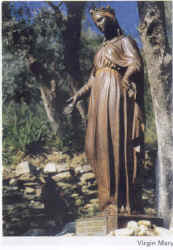
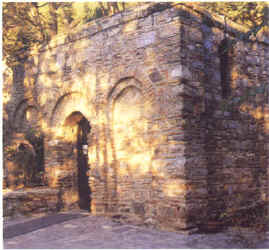
Virgin Mary Virgin Mary House
*
Konak Square
Konak
Meydanı (Konak square) is the centre of İzmir city. Due to the presence of
such official institutions as the municipal and governorship buildings coupled
with a concentration of shopping facilities in this square, it setrves as a
meeting and intersecting point for transportation within the city.We invite you
to follow us on a step-by-step tour of İzmir, starring with Konak Meydanı. On
this short tour, which we will be taking on foot, lets get acquainted with
the historical and cultural sites of İzmir.
Clock
Tower
This
monument was built in 1901 by the Otoman Grand Vizier Küçük Said Paşa to
commemorate the 25th anniversary of the coronation of Otoman Sultan Abdülhamit
II. The architectural design of the tower bears a resemblance to those of the
German Consulate building located on the 1st Kordon and St Polycarp Church in
Alsancak.Raymond Pere desinged them all. The tower is 25 meters in height and
has fountains on each of its four corners. The clock in the tower was a gift
from German kaiser Wilhelm II.
Government House
This
building, which is used today as the state building, was built between the years
1868-1872. It was later destroyed by fire in 1970 and restored to its orginal
state in 1971.
Old rıhtım and Customs Buildings
These structures were built in 1854, as the first
french customs building. It is believed that the architectural desing belongs to
the famous French architect Eiffel or his assistant. It remained the Customs
building for many years and later became the Customs House for marine products.
Known as the Konak Pier, The building has been restored to its orginal state and
is being prepared to an entertainment and shopping centre.
Elhamra
Built
by Turkish architectural Pioneer Tahsin Sermet, this structure is located on
Nadir Nadi Avenue. (Nadir Nadi was the first Beyler ruler.) The cinema section
of the building was opened in 1926 and the library in 1933. Today, this
building, which alsohouses the İzmir State Opera and Balet and the Public
Library, is a representative structure of İzmir.
Historical,
cultural and commercial sites of Kemeraltı
Kemeraltı is Turkeys largest
and İzmirs most colourful and lively bazaar. This bazaar, which contains
many historical houses, mosques, synagogues and hans (inns), has been the heart
of İzmirs commercial and businness life for 2,500 years and in this context
is unique in the world.
Kızlarağası
Hanı
One
of İzmirs most important structures is the Kızlarağası Hanı. This inn
was built in 1741. This two-storey rectangular structure, which has an iner
courtyard and four entrances, is a rare example of Ottoman architecture found İzmir.
The inn was restored in 1933 and today serves as a centre for sale of antique
goods, authentic gifts, second-hand boks, jewellery and leather products. It
also contains several tea salons and coffeehouses.
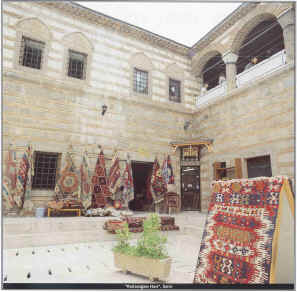
Kestane
pazarı (Chestnut Market)
This market
is full of life all day long. It is a long narrow street dotted with spice
shops, sweets shops, fishmongers, cheese-makers, pickle shops, wood carvers and
souvenir shops.
Bikur
Halim Synagogue
Bikur
Halim Synegogue, which is located in the İkiçeşmelik district, was first
built by Solomon de Ciaves, a Dutchman living in İzmir. The building was
destroyed in the great fire of 1772. In the year 1800 a new synagogue was
constructed in the same area by Manuel de Ciaves. Today this synagogue stands
out as İzmirs most beautiful and stil retains all the characteristics of the
original structure.
Bikur Halim
Address: Ikiçeşmelik caddesi No: 40
Havra
Street and the Synagogue
Havra
Street gets its name from the many synegogues that line it. It features an
interesting structure that bears a resemblance to the Kestane Pazarı in which
all varieties of foodstuffs are sold. In the 15th cuntury, at the invitation of
the Otoman Empire, Jewish families from Spain migrated to İzmir and made Havra
Street and its environs their home. The presence of many mosques in the area
side by side with the Ez Hayım, Bet Illel, Shalom, Talmud Tora, Sinyora and
Algazi synagogues is prof of the tolerance and brotherhood between the people of
both religions in İzmir.
(Sinyora Ivaret
![]()
Mosques
*English
Ayses Mosque (Isabey Yalı Mosque) 18th century work of art. This mosque
is located on Konak square.
*Kemeraltı
Mosque (1812) This mosque is located on Kemeraltı
853 and 856 streets.
*Salepçioğlu
Mosque (1906) This Mosque is located on Kemeraltı, 850 and 917 streets.
*Başdurak Mosque (1774) This Mosque is located on Kemeraltı Anafartalar Avenue and 863 street and is bounded
by 869 and 873 street.
*Kestane
Pazarı Mosque (1667) This Mosque is located on Kemeraltı 872 and 882 streets.
*Şadırvan
Mosque (1636) This Mosque is located on Kemeraltı Anafartalar Avenue and 912
street.
*Hisar
Mosque (1592) This Mosque is located on Kemeraltı Hisarönü.
*Hatuniye Mosque (18th
century) This Mosque is located on Kemeraltı Anafartalar Avenue.
*
House
Museum of Dario Moreno and the Historical Asansör
The
house in which the famous Dario Moreno used to live has been transformed into a
museum. The surrounding houses have been restored, and the street has been named
Dario Moreno Street. The 40-meter-high historical lift building (Tarihi Asansör)
that stands at the end of this street was built by the Jewish businessman Nesim
Levi in 1907 as a means of connecting the Karataş and Halil Rıfat paşa
quarters. At the top of this lift building are a restaurant that has a wonderful
view of the gulf of İzmir, the Ceneviz Meyhane (Genoese Wine - House) and a café.
Asansör is one of İzmirs most prestigious spots. In the 1930s a theatre
stage, a cinema, café and photography studio were installed in the Asansör
building.
Alsancak
Alsancak, which is the shopping and entertainment centre
of the city, used to be known as Punta.From Konak Square going towards the
eastern part of the city, Alsancak is a 30-minute stroll using either 1st
Kordon, the seaside road that also serves as a promenade, or the iner street,
Cuhhuriyet Blvd., you will see various representatice structures along the
way.Some examples of the republican architectural style situated here include
the Vakıf Bank, Garanti bank, Tourism Directorate, Ziraat Bank, Kardıçalı
Han and Stock Exchange buildings.
The
Hilton Hotel and the Grand Ephesus Hotel, which is currently undergoing
renovation as part of its transformation into the İzmir Ephesus Swissotel, can
all be seen from the square.You can take any one of the
surrounding roads to get to the Culture Park. The square contains a large statue
of Mustafa Kemal Atatürk, the founder of the Turkish Republic. Created by
famous Italian sculptor Pietro Canonica in 1932. Alsancak contains an abundance
of old İzmirian houses with boq Windows built in the Italian architectural
style, world-famous ready-made clothing shops, fast food outlets and countless
restaurant-café-bars and night clubs. In addition it is also the centre and
location for numerous consulates, movie theatres and cultural centes. The areas
that are closed to heavy trucks and only open to pedestrians are lively 24 hours
a day.
Dantel
Sokağı (Lace Street)
Dantel Street is a long, narrow street that opens up to the Kıbrıs Şehitleri main street. It is so narrow that were you to spread out your hon both sides, you would be able to touch the walls of the houses on either side of the street. The street has an interesting architectural style.You will be spoiled by the huge selection from which to choose gifts for your friends in the handicraft and authentic goods shops that can be found on either side of this street.
Alsancak
Train Station
An 1858 structure, the train station is a fine
example of English architectural style. The resemblance borne by the district to
a typical English village was
further strengthened by the addition of a clock to the station building in 1865.
This was the first clock tower in İzmir.
![]()
*
Catholic
Churches
St.
Polycarp Church
This church
is located at the intersection of Gaziosmanpaşa Blvd. And Necatibey Blvd. On
the way from Cumhuriyet Square to Basmane. The building was built in 1625 in
honour of St. Polycarp, who was killed in A.D. 155 in Kadifekale at the age of
86 because of his strong beliefs and faith. It is İzmirs oldest church and
is open to the public every day throughout the year.
(Address: Necatibey Blvd. No. 2
St.
John Dome Cathedral
This church is located on
Şehit Nevres Blvd., which leads from Cumhuriyet Square to the Culture
Park Fairground. It is open to visitors daily throughout the year.
Santa
Maria
This
church stands behind St. Polycarp Church on Halit Ziya Blvd. It is open to
visitors all year round.
(Address: Halit Ziya Blvd. No. 67
Notre
Dame de St. Rosarei
This
church is located on 1481 street and is open all year round.(Address: 1481
Street No. 8, Alsancak
Telephone: 00-90-232- 484-66-66)
Anglican Churches
St. John the Evangelist Church: This churchis located at
the intersection of Talatpaşa Blvd. And Mahmut Esat Bozkurt Avenue.
Orthodox
Churches
Aya Fotini: Built in 1793, the church is only open on
important holy days.
![]()
*
Culture Park (Kültür Park)
The Culture Park is one of the largest areas of greenery
within the city. In addition to the beautiful Mediterrnean palm trees lining the
park, there are also various other plants and flowers. Culture Park is İzmirs largest recration centre, with its zoo,
gardens, funfair, sports facilities, theatres, open-air cinema and more. The İzmir
International Fair is held at the Culture Park
Fairground every year between Aug. 26 and Sept. 10. The atmosphere
generated by this event is one worth experiencing.
Kadifekale
Kadifekale (castle) was built in the 4th century B.C. by Lycimachos, one of
Alexander the Greats generals. Today only the southern wall and five towers
remain from the old Kadifekale. The iner castle structure is an example of
Middle Ages architecture. The castle was built on a six-square-kilometre area,
and its towers measured 20-35 meters in height. The eastren and northern
sections of the castle have been totally destroyed, and the interior of the
castle is now a forest of pine trees. The remains of a water cistern can also be
found with in the castle. The Pagos Hills are one of İzmirs must-see sites
because the panoramic view of the city is well worth experiencing.
Agora
The
Agora, or market place, of Smyrna was located on the northern slopes of the
Pagos Hills that face the bay. It was built during the Hellenistic era and
connected via a broad street from the North to the trade Agora at the port
district. After a destructive earthquake in 178 BCE, the Roman emperor Marcus
Aurelius rebuilt the city. On the North side there is a basilica and in the
basement of the building there are grafitties, which are unique examples in the
world.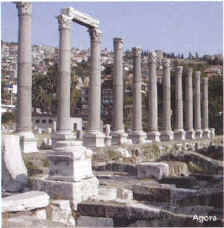
İzmir
Archaeology Museum
This
museum is loceted in Konak at the sarting point of the Varyant, which connects
konak to izmirs most populated district of Hatay. Next to this museums is the
İzmir Ethnography Museum. The
museum contains exhibition halls, laboraties, stroage facilities, photography
halls, a library and a conference room to accommodate all sorts of requests
concerning the materials found here. The three-storey museum building has been
divided into sperate exhibition section. In the top-floor salon are artefacts
from the ancient cities of Lasos, Çandarlı and Pergamon. In addition ceramic
Works from the Proto-geometric and Geometric periods of western Anatolia, Myrina
Eros statues glass pieces, coins and a bronze statue of Demeter are also on
display here. The middle flor, which is also the entry flor of the museum,
displays marble art objects. Statues, busts and portraits from the Archaic
period to the end of Roman period can be found here. On the garden flor, which
is also the first flor, marble friezes from the Roman period as well as colossal
statues and tombs are on exhibit. The Ekrem Akurgal Hall, which displays ceramic
art from the Proto-geometric and Geometric periods of western Anatolia, was
opened in 1999. We suggest that you visit all these sections in order to get an
idea of the cultural and socioeconomic situation of those times.(Bahri Baba Parkı
Konak (Park) Telephone: 00-90-232- 489-07-96)
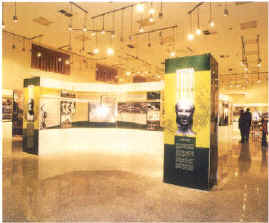
Culture Park
History and Art Museum
İzmir has gained a new museum at the begining of 2004. The history and Art
Museum in Culture Park is formed by 3 seperated buildings. Besides the
archeological monuments, a precious monument hall and the very best extensive
coin collection of Turkey are also on display.
İzmir
Ethnography Museum
Built
in 1831 as the Rock Hospital, the building was turned into the Ethnography
Museum in 1987. Situated next to the İzmir Archaeology Museum, the first and
second floors of this three-storey museum host exhibition halls, while the third
flor serves as a laboratory, photography salon and storage room. Items that show
a cross-section of the social structure of İzmir and its surroundings in the
19th century are on display in the exhibition halls.Samples of traditional
Turkish crafts such as boat building, clog making, pottery, carpet weaving, rope
weaving, felt weaving and saddlery are also on view here.
(Open every
day except Monday between 08:30-12:00 and 13:00-17:00)
İzmir City
Museum and Archives
The Central Fire Brigade building, one of the
representative buildings of İzmirs history from the republican period. The
meseum will contain special documents concerning İzmir and photographs as well
as personel information and family histories. Exhibition halls, a library and
several rewading rooms will also be avaible for interested parties who wish to
cunduct research. The museum will be an important centre of discovery. This
historical building was put into service as the Central Fire Brigade in 1932,
which operated here non-stop for 70 years until the end of 2001, when it was
moved to a new location.
Atatürk
Museum
Located
on the 1st Kordon, this two-storey house was the building where Atatürk used
tos tay on his visiits to İzmir. The residence was constructed between 1875 and
1880. Atatürk was staying in this house on Sept. 17, 1923, when he participated
in the first İzmir Economic Congress. The house was given to him as a gift in
1926. After his death it was opened to the public as a museum in 1941. The house
bears traces of both the Otoman and Levantine cultures and attracts attention
because of its neo-classic architectural style. Five marble steps lead to the
semi-circular entrance of the house from the centre of the houses front
section. From this door you enter into the ground flor salon. The flooring of
the house is all wood, and the roof has rich and beautiful desings. On exhibit
here are Atatürks personal belongings.
*
![]()
*
What to eat ?
Seafood
İzmirs cuisine is primarily composed of
seafood.barbun fish, actopus and squid, perch and gilthead bream, which are
transformed into mouth-watering delicacies in İzmir.Shrimp, sea urchin and
cidonnia are also prepared very well. You can sample delicacies unique to the
Aegean region onion piyazlı, grilled perch with black pepper, carrots,
potatoes and onions in the fish restaurants that line the Kordon as well as
in the İnciraltı, Narlıdere, Güzelbahçe, Urla, Çeşme and Foça district.
Authentic
Flavours
İzmir
and its environs are rich not only in seafood but also in a mixture of Aegean,
Mediterranean and Anatolian dishes. The abundant vegetation and the variety of
athnic groups are the main reason for this rich mixture. Tere soup, Tarhana
soup, Keşkek, Zerde, İzmir meat balls, Ödemiş kebab, Tire meat, balls, Boyoz
(a kind of Jewish pastry), Papaz Yahni, roast beef, Mücver, tomato soup, Kol böreği
(pastry), gerdan, Tel kadayıf and radicchio salada re some of İzmirs famous
cuisine. We advise you to try some some of these authentic dishes.
Çöp Şiş
İzmir also has a large vaiety of kebabs, pide and
other authentic dishes. Located close to Alsancaks Cumhuriyet Square, the Topçunun
Yeri restaurant.You should definitely try them.!
International
Flavours
İzmir
is a very modern and cosmopolitan city, so of course you will be able to find
various international restaurants here.Chinese, Italian and French cuisine
awaits you in Alsancak.
Turkish
Wines
In 1993 the worlds most respected wine magazine, Wine Decanter, conducted a
poll on wines that would be preferred in the 21st cuntury and preented the
results to its readers.The survey asked about important characteristics of wine,
such as, Which
countries will show amazing progress by the end of the century?
and Where would you
like to grow your grapes in the year 2000?
Turkey producs 22 varieties of domestic grapes including Boğazkere, Öküzgözü
and Kalecik Karası for red wine, while Emir is of world-class standard for
white one. Turkey also grows 12 varieties of foreign grapes (Cabernet Sevignon,
Merlot, Carignan, Shiraz, Chardonnay, Sauvignon, Blanc and so on). In addition
to the government monopoly, 45 private companies produce wine. Wine production
is widespread in Turkey but is
particularly predominant in Thrace and the Aegean region. The use of the same
methods as in French chateaux has increased the quality of existing Turkish
wines and introduced new ones.
Turkeys World Brand : Rakı
Turkey
is the motherland of the Mediterraneans popular and beloved drink, Rakı.
Although France, Italy, Spain and Greece all have a type of rakı, Turkish Rakı
is a whole different experience. Produced only İzmir-Çeşme and made from
grape alcohol, Turkish Rakı is popularly known as lions
milk.
What to buy?
İzmirs
commerce has been conducted for close to 100 years in the commercial centre of
Kemeraltı. The area hasnt changed much over the years and stil maintains its
ancient look with shouting merchants, the sound of metalworkers, fishermen in
wet aprons and the fountain next to Sadirvan Mosque. Rope makers, jewellers,
printers, shoe-makers and ironsmiths all stil work in Kemeraltı as well. You
should definitely visit Kemeraltı when you are in İzmir in the future! İzmirs
modern shopping facilities are loceted on the Kordon in Alsancak and on
Cumhuriyet Street in Karşıyaka. Kemeraltıs neighbouring area, Çankaya,
has many exclusive boutiques and shops, and from there you can visit the shops
in Alsancak and Karşıyaka to shop some more. In addition, beautiful Turkish
carpets and kilims with wonderful motifs and designs are displayed in countless
shops. Beautiful examples of gold and silversmith work, leather shops and
souvenir shops can be found all over İzmir. In addition to Kemeraltı shopping
district, you can also find whatever you want in Alsancak, Konak, Çankaya
and ofcourse outside of İzmir in Çeşme, Selçuk and Bergama. If you are
interested in Middle Eastern belly dancing and want to take home a costume, İzmir
is the right place to be. İkiçeşmelik İzmir single-handedly supplies
belly-dancing costumes from this area at a fair price.
Must-see
Kızlarağası
Han (inn), the historical Elevator, Clock Tower, Old Rıhtım and Fair
İzmir
Archaeology Museum, İzmir Atatürk Museum, the Kordon, Kemeraltı bazaar and
Havra Street
should definitely visit before leaving İzmir
Must eat and buy
İzmir
meat balls, sea foods, Turkish hors doeuvre and çöp iş kebab
Dried figs and grapes can be found in many shops arround İzmir; however, the tariş shop in Konak sell the best quality at fair prices. Kemalpaşa cherries, Bergama Tulum cheese, a few bottles of turkish Olive oil
*
We
saluet
with
love
;
Nineteen...
*
 Copyright©.www.ondokuz.gen.tr
Copyright©.www.ondokuz.gen.tr